
The Basics:
- For ages 7 and up (publisher suggests 12+)
- For 2 to 4 players
- Approximately 60 minutes to complete
Geek Skills:
- Counting & Math
- Logical & Critical Decision Making
- Reading
- Pattern/Color Matching
- Risk vs. Reward
- Hand/Resource Management
Learning Curve:
- Child – Easy
- Adult – Easy
Theme & Narrative:
- Grab your vampire slaying gear! It’s time to hunt the undead!
Endorsements:
- Gamer Geek rejected!
- Parent Geek mixed!
- Child Geek approved!
Overview
The land is plagued by unnatural beasts and horrific monsters. The townspeople know they are safe when the sun is in the sky, but hide behind locked doors at night fearing for their souls. The town leaders have sent for help and you have answered their call. You know that a vampire of great power lurks in the woods that borders the town. Gathering what equipment is available, you venture into the old and rotted forest to hunt the evil down. You know not what awaits you, but are confident enough in your skill to step bravely into the gloom. The townspeople see you off and then say a silent prayer, for many have entered the woods but none have returned.
Hunter’s Guild: The Vampire Forest, designed by Robb De Nicola and published by Epic Scale Games, is comprised of 100 Day cards, 100 Night cards, 7 Hunter cards, 8 Class cards, and a standard twenty-sided die. The cards are as thick as your standard playing card and the die is nothing special. Worth mentioning is the artwork by Robb De Nicola and Filis Ann Ozkurdum. Simply excellent and does a great job of furthering the game’s visual narrative and theme.
Preparing for the Hunt
To set up the game, separate the Day and Night cards into separate decks. Give both decks a shuffle and place them face-down in the middle of the playing area. Leave room for a discard card pile for both decks.
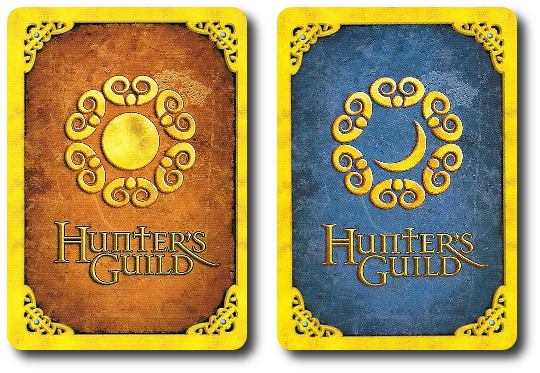
Day card on the left, Night card on the right
Second, either let each player select a Hunter card or randomly deal 1 Hunter card to each player. Hunter cards are all the same except for the artwork. Players place their Hunter card in front of them, non-infected side face-up. Any Hunter cards not used are returned to the game box.
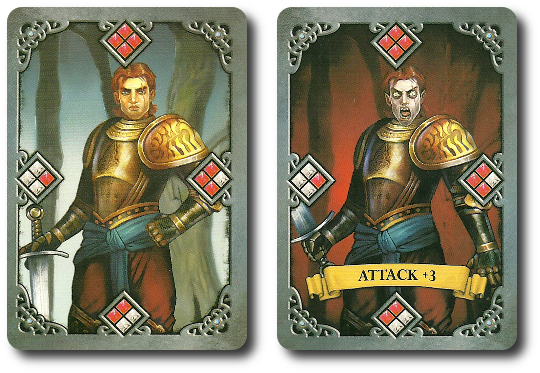
Non-infected hunter on the left, infected hunter on the right
Third, and optionally, allow each player to select a Class card or randomly deal 1 Class card to each player. Class cards give the player a bonus, but they can also penalize a player if they should ever become infected with the vampire curse. Any Class cards not used are returned to the game box.
Fourth, deal 4 Day cards to each player, face-down. This represents the starting equipment and items the player has that will aid them in their hunt.
That’s it for game set up. Determine who should go first and give that player the twenty-sided die. Turn order sequence is clockwise around the table starting with the first player.
Hunting Evil
Hunter’s Guild is played in rounds, phases, and turns. A round includes 2 phases (Day and Night) and every player takes a single during each phase. For example, in a 4-player game, each player would take a turn during the Day phase. After the Day phase ends, the Night phase begins and the players take another turn starting with the first player. A typical round is summarized here.
Phase 1: Day
During the Day phase, and starting with the first player, the following actions are taken by each player on their turn.
Action 1: Draw 1 Day Card (Optional)
The first thing a player may do (it’s an optional action) is draw 1 Day card and add it to their hand. Players have a hand size limit of 8 cards. The Day draw deck contains armor, weapons, equipment, and special actions the player needs to hunter, kill, and survive.
Action 2: Play Equipment Cards (Optional)
The second thing a player may do (again, it’s optional) is play Day cards in front of them. Now is the time to equip a hunter, but certain rules apply. Hunters can only equip one type of equipment at a time. This means a hunter can only have 1 armor, 1 weapon, and 1 shield. Some weapons take 2 hands, which means the hunter cannot equip a shield if a two-handed weapon is already equipped. If a weapon is no longer needed or a piece of armor is damage, it can be swapped out and discarded by equipping another card of the same type. Let’s take a closer look at what you can give your hunter and why you should care.
Weapons give hunters a bonus to hit, damage, or both. Combat is done rolling the twenty-sided die. Whatever value is rolled is the hunter’s attack roll. Which, honestly, could be pretty miserable. By equipping weapons, the hunter is given a permanent bonus to their roll for as long as the weapon is in hand. Weapons also allow a hunter to hit harder, as well as more frequently. This means less time fighting for survival and more time hunting for monsters.
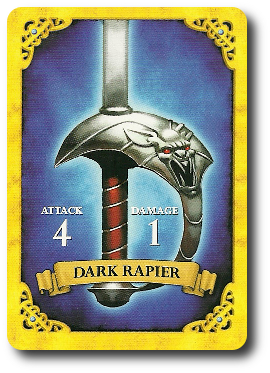
Armor protects the hunter and takes damage before the hunter does. Some armor is stronger than others, and as a result, can take more damage before it becomes useless. The shield is a special piece of armor that can be equipped, but only if the hunter is wielding a one-handed or no weapons.
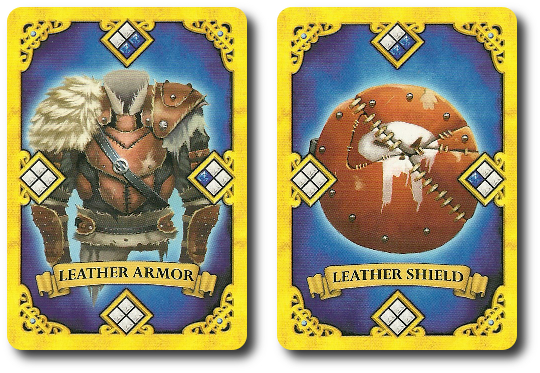
Item and bonus cards are also included in the Day draw deck, but are not placed in front of the player at this time. Instead they stay in the player’s hand and can be played when they are called for. Examples include healing potions, antidotes for infected players, vampire slaying equipment (more on that later), and combat bonuses.
After a player plays their cards, they need to check if they have 8 cards or less in their hand. If they do not, they must discard down to 8.
After every player has had a turn, it’s time to get ready to hunt!
Phase 2: Night
Nighttime is when all the creepy, evil, and slimy creatures come out to cause chaos. Hunter’s love this time of day and your hunter is no exception. Again, in turn order sequence starting with the first player, each player will draw 1 card from the Night draw deck and encounter whatever it might be.
It’s a Monster!
If a creature is drawn, it’s time to battle. To battle the creature, the player takes the twenty-sided die and rolls it. The goal here is to roll a number equal to or higher than the creature’s level. Players should add their weapon bonuses if they have any and play cards from their hand if they think it’ll help. If the player does roll a number equal to or higher than the creature’s level, the creatures takes 1 or more damage (depending on the weapon being used by the hunter, default is always 1). If the player failed to roll a number equal to or higher than the creature’s level, the creature attacks and does 1 point of damage.

There are two exception to the “high” and “low” numbers being rolled during combat. If a player rolls a value equal to the creature’s level (note that I state “roll”, not “adjusted with bonuses”), the creature is immediately destroyed regardless of how much health it might have. If a player rolls a “1”, the creature and the hunter take no damage (thematically, both the creature and the hunter dodged out of harms way).
Most combat is done between the player who encountered it and the creature. Combat is always to the death. The two exceptions are special Day cards that allow the hunter to retreat and encounters with a creature that allow every player to participate. These creatures have an “All Slay” (see what they did there?) noted on the card. Starting with the player who drew the creature and continuing in turn order sequence, each player gets to take one swing at a time at the creature until it’s dead or all the hunters are dead. “All Slay” creatures tend to be much more difficult to take down and will oftentimes take down one or more hunters before they drop. If it helps, think of them as “mini bosses” in the Vampire Lord’s army. A good example is the “Oak King” who has destroyed more hunters than I care to count…
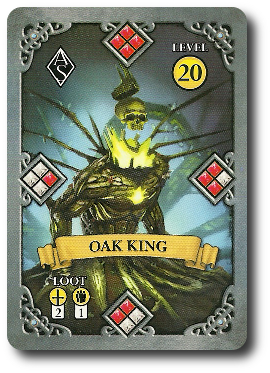
Prepare to be spanked…
Damage is tracked by rotating Hunter, creature, and armor cards counter-clockwise. When a card is first played, it’s placed so the most numbered “gems” are located at the top of the card. As the card takes damage, it’s rotated once to the card’s next edge going counter-clockwise for every 1 damage it takes. For creatures, this rotates the creature card once per damage. For a hunter, this will first rotate any armor and then the Hunter card.

From left to right: full life to only 1 hit left
If a creature is defeated, it will list how much loot (Day cards) the player gets. If the creature allowed all the player’s to join in, the creature card will show how much loot the player who slayed the creature is awarded (the player who landed the killing blow) and how much loot everyone else gets. Not all creatures drop loot, however, meaning the reward for winning is sometimes just surviving.
Thieves!
While hunting, the player might draw a Night card that thematically runs their hunter into a group of thieves. No combat is done, but the player must discard 1 card from their hand. It’s up to the player do decide what card will be discarded.
Butterfingers and Getting Lost
While traversing the woods at night, a hunter could lose a weapon or their armor. If the player’s hunter doesn’t have these cards equipped, then the card is ignored and discard. If the player does have a weapon or a piece of armor equipped, they discard the Night card and lose the armor or weapon they have currently on their hunter. Worse yet, the hunter could become lost in the woods and stumble around all night and all day!
No Encounters and the Breaking Dawn
It’s perfectly possible (albeit unlikely) that a player will draw a card that results in no encounters. The hunter will go home with nothing to show for their efforts. It’s also possible (and as equally unlikely) that the player will draw a card that represents the dawning of the sun. This ends the Night phase, regardless if all the players have gone or not.
The Vampire Lord
The players are looking for the Vampire Lord, but all of his evil minions and other nasty things that live in the forest keep getting in the way. That is actually a very good thing, because the Vampire Lord is a badass. How bad you ask? Let me put it this way…you cannot engage him in combat. Ever. He will always win. Also, he looks really good in armor, which deserve respect. Just look at this vampire’s fashion sense!

Stylin’!
The only way to stop the Vampire Lord is to discard 4 special Day cards that represent the necessary vampire slaying equipment. If the player does have the equipment in their hand when the Vampire Lord is encountered, they can take him down. If they don’t, there are only two possible ways the encounter will end. The first is by discarding 1 of any of the special vampire slaying equipment the player might have in their hand. Doing this allows the player to escape the Vampire Lord. The second and much more likely outcome is that the hunter will become infected.
Infection and Cures
If the hunter becomes infected, the player will immediately flip their Hunter card to the infected side with full health. Note how evil and somewhat vampire-like the hunter has become. This is a clue about the hunter’s current state, which as it happens, has its ups and downs. If the player is using a Class card, it should be rotated 180 degrees, as well. The player’s hunter no longer gets the full benefits of their selected class. The only cure is an antidote (found in the Day deck) or killing the Vampire Lord.
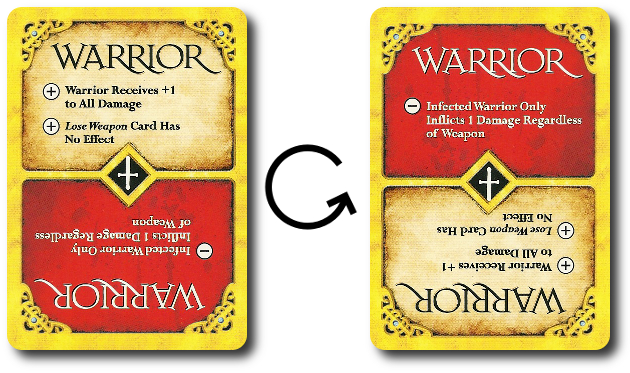
On the upside, infected hunters can “Feed” on defeated creatures to heal and can feed at random through Night cards. Infected hunters are also much stronger and get a +3 to all attack rolls. This is in addition to any weapons the hunter might have equipped. Not bad, eh?
On the downside, daylight now hurts something fierce. If the player wants to take any actions during the Day phase, their hunter suffers 1 damage. And the nighttime isn’t much better. If an infected hunter draws the Vampire Lord during the Night phase and DOES NOT have all the vampire slaying equipment or one of the vampire slaying equipment available to discard, the hunter becomes the Vampire Lord’s slave. The player must discard all the cards in their hand and in front of them. During the next Day phase, they get to start over with a fresh new Hunter and 4 new Day cards.
Death and Victory
If a hunter ever takes damage enough to fully rotated 360 degrees, they are slain. The player discards all the cards in their hand and any cards in play. During the next Day phase, they start as a new hunter will full health and 4 new Day cards. Yes, it’s the same fate as hapless infected hunters who stumble upon the Vampire Lord without proper protection. Death and undeath are the same thing in Hunter’s Guild.
If a hunter, regardless of their health and current state of infection, should ever come across the Vampire Lord packing all 4 type of the vampire slaying equipment in their hand, it’s time to send the bloodsucker to oblivion. All 4 vampire slaying cards are played and the Vampire Lord turns to dust and bone. HUZZAH! The land is free from the vampire’s tyranny and the player who slew the Vampire Lord is the game’s winner.
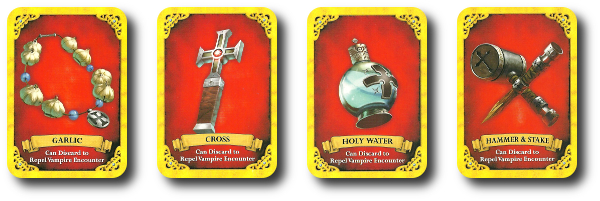
To learn more about Hunter’s Guild: The Vampire Forest, visit the publisher’s website.
Prediction
This game looks great, but I’m concerned that looks are masking the game’s possible lack of substance. The game play is very straightforward, but perhaps a bit too simple for our more serious and older players. At its core, this game can be summarized as follows:
- Draw card
- Play card/Discard card
- Draw card
- Roll dice
- Draw card (if loot)
- Repeat
Admittedly, this is a super-simplified breakdown of the game, as there are some decisions to be made. For example, what cards to play and later discard. But, that’s about it. Everything else about this game is out of the player’s hands. For our younger players, I think they’ll be amused with the game’s theme and the easy game play. The excitement of finding new equipment and the danger of exploring the forest at night will give them a good mix of fun. For the Parent Geeks, I think they’ll tolerate this game after the second play. They might quickly find that each game is more or less the same. As for the Gamer Geeks, unless they are big fans of games-on-rails (game’s that don’t require much in the way of decision making), Hunter’s Guild is going to fail.
Teaching Hunter’s Guild is very simple. I suggest you discuss what happens during the day, during the night, and the few decisions the players’s need to make during both phases. Remind players that the only way to kill the vampire is to find the right equipment, which is only possible by surviving the night. The difficulty of finding the right equipment (random card draws) is made even more difficult with the hand limit size of 8 cards. Other than that, make sure players understand how combat works and how to heal or repair armor. You will also want to spend time discussing how the game subtly changes when the player’s hunter turns into a vampire. Other than that, the game pretty much explains itself during game play. Note that the publisher suggests that the minimum age is 12-years-old. However, what text there is in the game is minimal and younger players shouldn’t have a problem playing if assisted by an older player.
And so, after teaching the game to my 2 oldest little geeks, I asked them their thoughts on Hunter’s Guild so far.
“Game looks really nice and sounds easy to play.” ~ Liam (age 10)
“I like how I get to equip my guy with awesome weapons!” ~ Nyhus (age 7)
My little hunters are ready to venture into the dark wood and kick undead butt. Let’s see if we have a successful vampire hunt or this game sucks…our blood.
Final Word
The Child Geeks really, really, REALLY enjoyed Hunter’s Guild. Even going so far as to wanting to play it in the morning before they had breakfast and saying “no thanks” to the television and video game console to have a chance to kill the vampire. I should also mention that Child Geeks as young as 7 played and did exceptionally well. The math is easy and there is no reason for other players to avoid helping each other out with card reading and making helpful suggestions. Child Geeks younger than 7 did well, too, but tended to lose interest. According to one Child Geek, “I really like this game! I like how I can mix and match weapons and armor and hunt down nasty monsters!” Another Child Geek exclaimed, “I love turning into a vampire! You get so many neat powers and can still be a good guy!” The Child Geeks tried the Class cards, but they often left them out. When I asked why, one Child Geek said, “I don’t think the game needs them. It’s fun the way it is.” All the Child Geeks voted to approve Hunter’s Guild, giving it their full endorsement and admiration for being a very fun game.
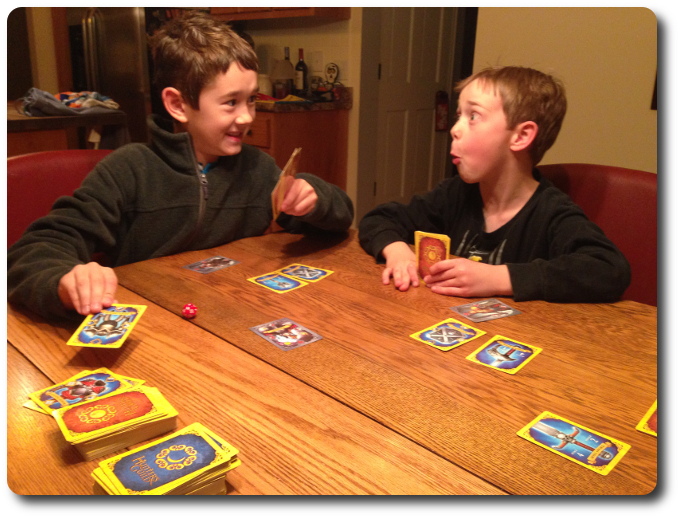
My 7-year-old goes “OOOH!” after my 10-year-old loses his armor
The Parent Geeks were very mixed with this game. They all enjoyed playing the game with their Child Geeks, finding it to be a fun game that could be played casually, paused easily for snacks or breaks, and wasn’t a game where age and greater skill always won. What they didnt’ care for was the game’s length and repetitive nature. According to one Parent Geek, “This is a game that can take 30 minutes or well over an hour. If you find all the vampire slaying gear you still have to find the vampire. But finding anything is random and I cannot improve my odds.” Another Parent Geek said, “I feel like I’m doing the same thing over and over and over again. It’s not horrible, but it’s not engaging.” There were aspects of the game the Parent Geeks enjoyed. One Parent Geek said, “This is a fun game to play with my kids and I like hearing them cheer each other on when they are in combat.” Another Parent Geek said, “As far as fantasy and horror games go, there aren’t many you can play with kids. This one is an easy family gaming table win for my family.” When all the votes were collected, the Parent Geeks both enjoyed and disliked Hunter’s Guild, awarding it a mixed vote of approval.
The Gamer Geek did not care for Hunter’s Guild. According to one Gamer Geek, “This game had promised, but quickly failed to deliver. All I am doing is drawing cards, rolling dice, and not being given any choices.” Another Gamer Geek said, “Random, all based on luck, and what little there is to think about has little impact to the overall game.” All the Gamer Geeks found the game to too simple and without any meaningful depth of play. They really didn’t care for the victory condition being held hostage by random card draws and thought it was horrible how the game could technically never end (players are never out of the game for anymore than a round of play). They did think the artwork was excellent and the method in which players keep track of damage was smart, but that’s about it. Clearly, Hunter’s Guild is not a game for our gaming elitists. No love from this group meant no approval.
Hunter’s Guild was the most popular with the Child Geeks and the Parent Geeks who played with their Child Geeks. Most Parent Geeks didn’t care for the game, finding it to be too repetitive and long. As for the Gamer Geeks, they couldn’t look past the random card draws, lucky rolls of the dice, and how little decisions making there was in the game. I believe what we have here is a very casual game that is perfect for non-gamers and younger gamers, but most certainly not a game that is for everyone. Especially for those players looking for an engrossing dark fantasy game with difficult choices the could mean the difference between life or undeath. Visually, the theme and narrative is there, but none of the dark and brooding danger is found in the game play.
From a Gamer Geek’s perspective, I didn’t care for this game much. I never felt like I was hunting anything other than cards, I disliked the inability to organize beyond the random cards I found, and I rolled my eyes constantly that I couldn’t work towards the game’s goal in a purposeful manner. I’m a hunter of the undead, for goodness sake! I should be able to walk into any town, find the closest church, and get what I needed to end the tyranny of evil. But you can’t and the game becomes stale very quickly as a result. Too many times I felt like the game was playing me rather than me playing it. Furthermore, I never felt like I was playing the game with friends and family at the table. The one exception is the “All Slay” where all players get to contribute to the combat, but even that felt like the game was keeping all the players at a distance. This left me feeling isolated and bored almost immediately.
From a Parent Geek’s perspective, I tolerated the game. My little geeks really enjoyed playing it, held their breath during each die roll, and excitedly drew each card. That’s pretty awesome. The enjoyment and excitement they radiated made playing the game with them a good time. When we all took down the Oak King, we did a dance. When my oldest found the vampire with all the right equipment, we all cheered as if we had collectively won. Best of all, everyone helped out by offering good advice, talking through pros and cons of cards, and even making suggestions on what cards to discard. Not too shabby.
In the end, Hunter’s Guild failed to deliver on too many levels to please the majority, but it still made many of our players happy. As I have always said, there is a game for every player and a player for every game. Hardcore gaming enthusiasts won’t find much to enjoy, but younger and less experienced players will certain have a good time. If you think Hunter’s Guild: The Vampire Forest is the right game for you, do hunt it down.
This game was given to Father Geek as a review copy. Father Geek was not paid, bribed, wined, dined, or threatened in vain hopes of influencing this review. Such is the statuesque and legendary integrity of Father Geek.




Another game I want to play with the kids!